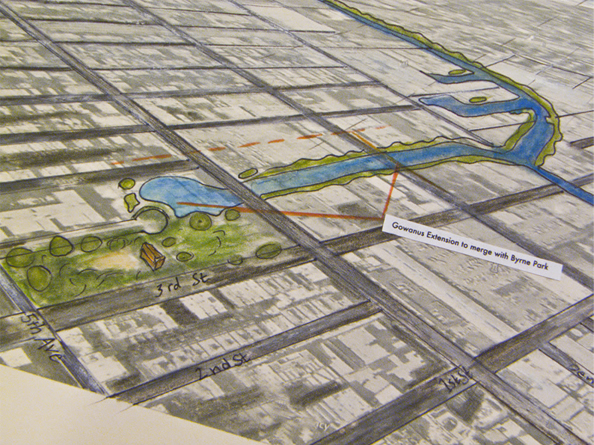A Utopia is an ideal place or state. With this in mind, Curator Katherine Gressel asks artists, youth, activists, architects, designers and urban theorists to consider different visions of an ideal Brooklyn.
The exhibit Brooklyn Utopias: Park Space, Play Space, exhibiting April 5-June 24, 2012, at the Old Stone House (OSH), invites artists to consider the history, politics, and planning surrounding public parks and recreation spaces. Participating artists will critically respond to past and present notions of “utopian” park design and use; and/or propose their own visions for ideal public spaces. This exhibit will correspond with re-opening ceremonies for the newly renovated Washington Park/J.J. Byrne Playground neighborhood hub.
Parks, playgrounds, and other public gathering spaces were historically designed as solutions to a range of urban problems from eliminating neighborhood blight to promoting health and wellness. Brooklyn, and New York City as a whole, are home to some of the grandest endeavors in urban landscaping: from Olmsted and Vaux’s Central Park and Prospect Park, to Robert Moses’ numerous playgrounds and pools, to the new Brooklyn Bridge Park and High Line. In a recent New York Times article, urban planning professor Christopher B. Leinberger mentions “a profound structural shift” in America during the last decade; instead of fleeing cities for car-centric suburbs as in the 1950s, people now favor “a walkable urban downtown” characterized by pedestrian plazas and pocket parks—leading to the development of such mixed-use public spaces as Times Square. How successful are these existing public spaces and what additional innovations are possible? How can the city’s history of park development inform its future?
These parks’ and streetscapes’ ongoing development also prompts questions of access as well as process—to what extent do local community members participate in decision making, and how? Are these spaces equitably distributed and maintained throughout the city’s diverse neighborhoods? How much have forces like eminent domain and gentrification been part of the equation? The recent “Occupy” protests have also questioned the use (or mis-use) of public spaces as well as privately-owned public spaces.
The artworks in Brooklyn Utopias: Park Space, Play Space will include both demonstration projects by artists who incorporate landscape design into their work; artists’ critical responses to existing public space developments; and artists’ visions for future “Park Spaces” or “Play Spaces” in Brooklyn. While the exhibit will consider Brooklyn as a case study, artists are also welcome to explore models in other boroughs and other cities.
—————–
Rebecca Hackemann, detail from “The Idea of the Gowanus Extension,” 2012, drawing, archival ink on archival paper, 11.5” x 15.5”
—————–
Find out more about Brooklyn Utopias
